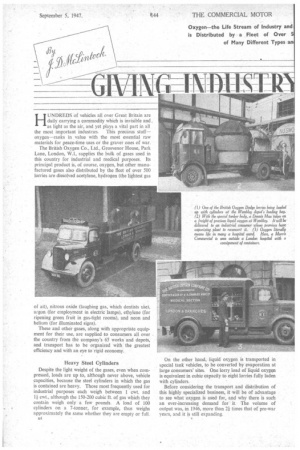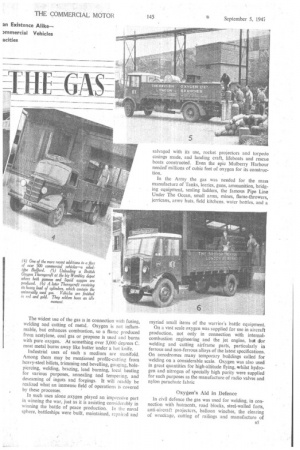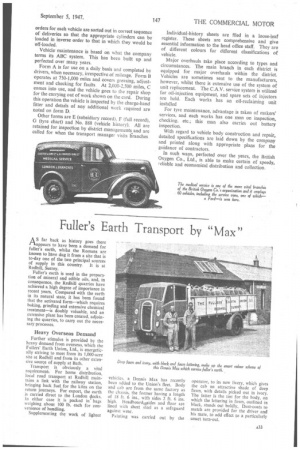H . UNDREDS of vehicles all over Great Britain are
Page 38

Page 39

Page 40

Page 43

If you've noticed an error in this article please click here to report it so we can fix it.
daily carrying a commodity which is invisible and. as light as the air, and yet plays a vital part in all the most important industries. This precious stuffoxygen—ranks in value with the most essential raw materials for peace-time-uses or the graver ones of war.
The British Oxygen Co., Ltd., Grosvenor House, Park Lane, London, W.1, supplies the bulk of gases used in this country for industrial and medical purposes. Its principal product is, of course, oxygen, but other manufactured gases also distributed by the fleet of over 500 lorries are dissolved acetylene, hydrogen (the lightest gas
of ail), nitrous oxide (laughing gas, Which dentists u.se), argon (for employment in electric lamps), ethylene (for ripening green fruit in gas-tight rooms), and neon and helium (for illuminated signs).
These and other gases, along with appropriate equipment for their use, are supplied -to consumers all over the country from the company's 65 works and depots, and transport has to be organized with, the greatest efficiency and with an eye to rigideconomy..
Heavy Steel Cylinders
Despite the light weight of the gases, even when compressed, loads are up to, although never above, vehicle capacities, because the steel cylinders in which the gas is contained are heavy. Those most frequently used for industrial purposes each weigh between 1 cwt. and cwt., although the 150-200 cubic ft. of gas which they contain weigh only a few pounds. A load of 100 cylinders on a 7-tonner, for example, thus weighs approximately the same whether they are empty or full. a4 On the other hand, liquid oxygen is transported in special tank vehicles, to be converted by evaporation at large consumers' sites. One lorry load of liquid oxygen is equivalent in cubic capacity to eight lorries fully laden with cylinders.
Before considering the transport and distribution of this highly specialized business, it will be of advantage to see what oxygen is usedfor, and why there is such an ever-increasing demand for it. The volume of output was, in 1946, more than 24 times that of pre-war years, and it is still expanding.
The widest use of the gas is in connection with fusing, welding and cutting of metal. Oxygen is not inflammable, but enhances combustion, so a flame produced from acetylene, coal gas or propane is used and burns with pure oxygen. At something over 3,000 degrees C. most metal burns away like butter under a hot knife.
Industrial uses of such a medium are manifold. Among them may be mentioned profile-cutting from heavy-steel billets, trimming and bevelling, gouging, holepiercing, welding, brazing, lead burning, local heating for various purposes, annealing and tempering, and deseaming of ingots and forgings. It will readily be realized what an immense field of operations is covered by these processes.
In such uses alone ,oxygen played an impressive part in winning the war, just as it is assisting considerably in winning the battle of peace production. In the naval sphere, battleships were built, maintained, repaired and salvaged with its use, rocket projectors and torpedo casings made, and landing craft, lifeboats and rescue boats constructed. Even the epic Mulberry Harbour needed millions of cubic feet of oxygen for its construction.
In the Army the gas was needed for the mass manufacture of Tanks, lorries, guns, ammunition, bridging equipment, scaling ladders, the famous Pipe Line Under The Ocean, small arms, mines, flame-throwers, jerricans, army huts, field kitchens, water bottles, and a myriad small items of the warrior's battle equipment.
On a vast scale oxygen was supplied for use in aircraft production, not only in connection with internalcombustion engineering and the jet engine, but Alior welding and cutting airframe parts, particularly in ferrous and non-ferrous alloys of the latest specifications. On aerodromes many temporary buildings called for welding on a considerable scale. Oxygen was also used in great quantities for high-altitude flying, whilst hydrogen and. nitrogen of specially high purity were supplied for such purposes as the manufacture of radio valves and nylon parachute fabric Oxygen's Aid in Defence In civil defence the gas was used for welding, in connection with hutments, road blocks, steel-walled forts, anti-aircraft pi ojecters, balloon winches, the clearing of wreckage, cutting of railings and manufacture of emergency farm equipment At the other end of the temperature scale, unexploded bombs were made harmless by freezing with liquid oxygen.
Reserves of oxygen were held at special points throughout the United Kingdom in case gas was used by our enemies, whilst the gas was indispensable for medical purposes in every sphere. The use of medical oxygen in surgery and therapy is, of course, one of the more important ones in days of peace.
In strange contrast, oxygen is used in peace-time, on the smaller scale, for such purposes as &ration of aquaria, melting of tiny portions of platinum, and the saving of life by resuscitation.
From Runabouts to Heavies At the present time a fleet of over 500 vehicles is operated by the company Makes are as follow: Albion, Austin, Bedford; Bradford, Commer, Dennis, Dodge, Ford, Fordson, Foden, G.M.C., Leyland, MorrisCommercial, Scammell, Singer and Thornycroft. Their carrying capacities range from 5 cwt. to 15 tons.
There are, in addition, many special tankers for liquid oxygen, as already described, which carry the uncompras&I equivalent of 105,000 cubic ft. of gas. These are nearly all oilers, as they do a big mileage without many calls. Also oil-engined are the majority of ordinary vehicles above 5 tons.
The fleet has been doubled in size since 1939, but even so, it can witri advantage be expanded, and new vehicles are being added as they become available. Annual fuel consumption is over 1,000,000 gallons. During the war vehicles were painted grey, but now all but about 25 per cent, are finished in the company's standard colours, which are Mercedes red with gold-leaf lettering.
The fleet is centrally controlled from London, the country being split up into operational districts, i.e., Scottish. North Western, Lancashire, Yorkshire, Midlands, Western, London-Wembley and LondonGreenwich. The largest number of vehicles is based on the Midlands and Wembley districts. Each district has a transport superintendent who is responsible for operational work, maintenance and staff details The transport manager is Mr C. F. Watts, M.1.T.A., and his chief assistant at Grosvenor House is Mr. A. E. Bennett. Such is the smooth organization of the centralized system of operation that they are able to direct with a very small staff. It is usual to have a transport conference each year, at which plans and problems, for' present and future, are thoroughly discussed and costs are analysed.
Administration follows an identical pattern in each district and all forms in use are standardized. A district superintendent could thus take over a new district without having to worry about procedure.
Operating costs are carefully collated and at the end of each quarter details of those for every district are sent to each branch in the form of a schedule and in order of merit. There is great competition to be in the first three. Each district is kept fully informed of what other districts are doing, and the standard is kept high. The secret of this centralized system would appear to lie in the fact that operational responsibility is delegated right down the line, from transport manager to superintendent and on to the individual driver
Getting the " Empties " Back
The prompt and continuous collection of empty cylinders, for refilling and quick despatch once more to consumers, is the only way to make these costly containers pay their way All loads are prepared in pyramids overnight, so that the complete fleet at a branch is loaded each morning within the hour. Every cylinder is numbered for identification and coloured to identify its contents. Delivery orders for each vehicle are sorted out in correct sequence of deliveries so that the appropriate cylinders can beloaded in inverse order to that in which they would be off-loaded.
Vehiclemaintenance is based on what the company terms its ABC system. This has been built up and perfected over many years.
Form A is for use on a daily basis and completed by drivers, when necessary, irrespective of mileage. Form B operates at 750-1,000 miles and covers greasing, adjustment and checking for faults At 2,000-2,500 miles, C comes into use, and the vehicle goes to the repair shop for the carrying out of work shown on the card. During this operation the vehicle is inspected by the charge-hand fitter and details of any additional work required are noted on form D.
Other forms are E (subsidiary record), F (full record), G (tyre chart) and No. 888 (vehicle history). All are retained for inspection by district managements and are called for when the transport manager visits branches. Individual-history sheets are filed in a loose-leaf register. These sheets are comprehensive and give essential information to the head office staff. They are of different colours for different classifications of vehicle.
Major overhauls take place according to types and circumstances. The main branch in each district is equipped for major overhauls within the district. Vehicles are sometimes sent to the manufacturers, however, whilst there is extensive use of the system of unit replacement. The C.A.V. service system is utilized for oil-injection equipment, and spare sets of injectors are held. Each works has an oil-reclaiming unit installed For tyre maintenance, advantage is taken of makers' services, and each works has one man on inspection, checking. etc.; this man also carries out battery inspection.
With regard to vehicle body construction and repair, detailed specifications are laid down by the company and printed along with appropriate plans for the guidance of contractors.
In such ways, perfected over the years, the British Oxygen Co,, Ltd., is able to make certain of speedy, reliable and economical distribution and collection.












































































